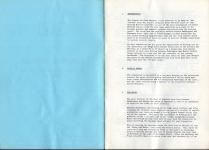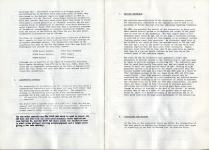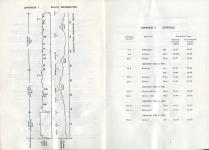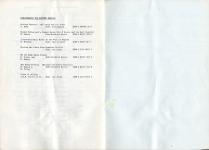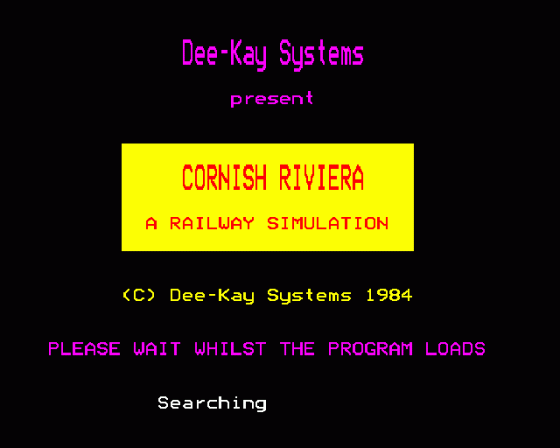
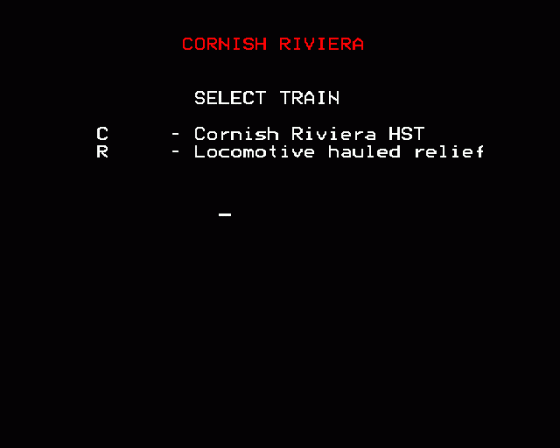

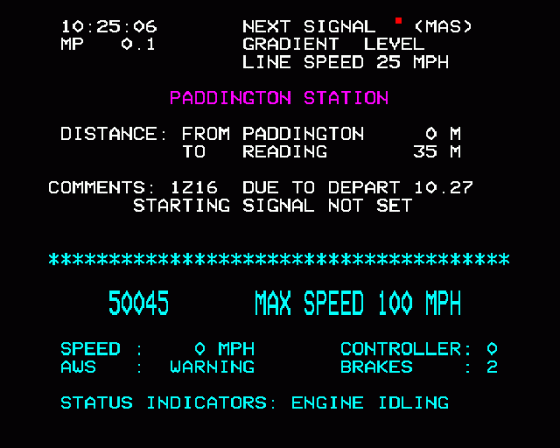
| Genre: | Game: Simulation |
| Publisher: | Deekay |
| Cover Art Language: | English |
| Machine Compatibility: | BBC Model B |
| Release: | Professionally released on Cassette |
| Available For: | BBC Model B & Spectrum 48K |
| Compatible Emulators: | BeebEm (PC (Windows)) PcBBC (PC (MS-DOS)) Model B Emulator (PC (Windows)) |
| Original Release Date: | 1st January 1984 |
| Original Release Price: | £9.99 |
| Market Valuation: | £2.50 (How Is This Calculated?) |
| Item Weight: | 64g |
| Box Type: | Cassette Single Plastic Clear |
| Author(s): | - |
Variant Items
There are 0 other items featuring this same game (that we know about!). Click any of them for their details.
Active Auctions
Closed Auctions
Buy It
Unfortunately no-one is currently selling this item.
Auction Price Watch
Worried you're being ripped off? Closing prices on eBay can help you decide what a reasonable price is for a particular item.
Full Instructions
Introduction
The Cornish Riviera express, still referred to by many as 'the limited' from the train's original Great Western title of "the Cornish Riviera Limited", is one of the most prestigious of modern British trains, with its very name conjuring up visions of the holiday beaches and romantic glamour associated with the Cornish coast. The train has run regularly between London Paddington and Penzance since 1904, and is famed amongst railway historians for its record-breaking long-distance runs and the slip coaches which used to be detached at speed en route to provide through connections to various seaside resorts.
In this simulation, you are given the opportunity of driving one of the Inter-City 125 (High Speed Train) formations of the present day Riviera, or a Class 50 or 47 diesel on a Summertime loco-hauled relief; in each case driving between Paddington and Exeter before being relieved by a new crew for the remainder of the journey westwards. The objective is to run your train to time, and despite the power of the modern locomotives you will find that this is no mean feat over the 173 mile route.
Display Format
The simulation is presented as a two part display on the television screen: the upper section giving information a driver would have from visual observations and his background knowledge of the route, and the lower section being a monitor of the locomotive controls and performance.
The Route
The main features of the West of England main-line between Paddington and Exeter are shown in Appendix 1, and it is convenient to describe the route in three sections.
Between Paddington and Reading is the high speed section, and after clearing the terminus speed restrictions, you will be able to rapidly accelerate your train on Brunel's finely graded Thames Valley line out of the capital. Not until the approaches of Reading does the gradient exceed ] in 1204, and on the slight downgrades between Hayes and Slough you may well have to ease back the controller to avoid exceeding the maximum speed allowed for your locomotive.
West of Reading the Riviera leaves the main-line to Bristol to take the 'Berks and Hants' line along the Kennet valley. This takes the train on a long and steepening climb to the summit at Savernake before a descent through the vale of Pewsey towards the busy town of Westbury on the edge of Salisbury Plain. After the Westbury and Frome cut-offs there is a sharp climb over the southern tip of the Mendips, and then an undulating descent through Castle Cary to Cogload, where the line rejoins Brunel's original route via Bristol (often referred to as the Great Way Round) for the run into Taunton. The track between Reading and Taunton is not laid out for high speed running, and it is only by a major programme of improvements that the line speed is gradually being raised above 90mph. Numerous restructions to lower speed remain however, and those adopted in the simulation are shown in Appendix 1. Although the speed of the HSTs cannot be used to advantage over this part of the route, the enhanced acceleration and braking capabilities of these units can be utilised by a skilled driver to keep his train running near continuously at the limit of the permitted line speed.
Beyond Taunton, the route climbs the first of the Devon banks which formed such formidable obstacles in the days of steam haulage. There is then the descent into Exeter alongside the M5 motorway, but here again restrictions on the line speed rule out sustained high speed running.
Details of place locations, gradients and line speed limits are given continuously throughout your journey. Mileages (given as decimal milepost readings) are the direct distance from Paddington rather than the actual milepost readings, which at various points en route refer to distances by other routes and do not allow for effects such as the 'missing 5 chains' at the buffers at Paddington and the shorter distances over the Westbury and Frome cut-offs.
In addition to the normal speed restrictions, you will encounter temporary restrictions due to engineering work on the track near Lavington and Hale, and details of these 'permanent way slacks' (pws) will be given at the start of the simulation. Advance warning will be given of all reductions in the line speed; 1.5 miles before a reduction of more than 20mph and one mile before all other reductions.
Schedules, Train Formations And Time-Keeping
The simulation is set on a weekday in the summer of 1982 and you have the choice of driving two trains; the Riviera itself (with reporting number 1B52) due to depart from Paddington at 10:25 and a special locomotive-hauled relief (with reporting number 1Z16) due to follow the Riviera down the main-line two minutes later. Both trains have pick-up stops at Reading, and are then scheduled to run non-stop to Exeter where you are relieved by a new train crew.
The Riviera will comprise of a standard Western region 7 coach HST set (see below), but the composition of the relief train may be varied from a nominal nine coaches (assumed to be of late type Mk II stock) depending on the anticipated passenger loading.
Details of the passing times of the principal locations and of the recovery times built into the schedules are given in Appendix 2, and you will be given reports on your progress as you reach the various timing points. You should attempt to arrive *on-time* at Reading and Exeter, and early arrivals (as well as late-running) will be penalised in the driver assessment at the end of the simulation for having unnecessarily 'thrashed' the locomotive only to have to wait in the stations until the scheduled departure times. (In this context, it is worth noting that the relief schedule can be kept without exceeding 95mph, although many enthusiasts may find it of interest to see if their particular locomotive can reach the magic 'ton' on the racetrack section to Reading).
Motive Power
The main characteristics of the three types of motive power available in the simulation are given below:
| HST | Class 50 | Class 47 | |
|---|---|---|---|
| BR Designation | 253 | 50 | 47/4 |
| Numbers available in simulation |
253001-18 253028-40* |
50001-50 | 47500-02 47507-13 |
| Builder | BREL | English Electric | Brush/BREL |
| Introduced | 1976 | 1967 | 1962 |
| Axle type | Bo-Bo | Co-Co | Co-Co |
| Engines | Paxman Valenta | English Electric | Sulzer |
| Horsepower | 4,500+ | 2,700 | 2,580 |
| Maximum speed (mph) | 125 | 100 | 95 |
| Length | 58' 5" | 68' 6" | 63' 7" |
| Height | 12' 9" | 12' 11.75" | 12' 9.5" |
| Width | 8' 11" | 9' 1.25" | 9' 2" |
| Weight (tons) | 70 | 115 | 121 |
* For details of power cars allocated to individual sets, see Modern Railways Pictorial Profile: 1 High Speed Trains. Publ. Ian Allan (1983)
+ From 2 power cars
HSTs were first introduced onto the Penzance route in October 1979, with the full service on this line beginning the following May. The gap in the set numbers available in the simulation is due to the batch of units transferred to Midland line duties. The units 253028-40 were a second build, specifically for West of England services, but they are now used indiscriminately with the original units all over the Western region.
The Class 50 locomotives are a development of the English Electric prototype DP2. Introduced originally as a stopgap prior to electrification of the West Coast main-line north of Crewe, they were moved to the Western region in large numbers in 1974 as replacements for the 'Western' class diesel-hydraulic locomotives. From 1977 onwards, they were named after Royal Navy ships to become officially a second generation of 'Warship' diesels, but are more commonly known to enthusiasts as 'Hoovers' from their distinctive noise signature. Since 1979, there has been a systematic programme of locomotive refurbishment to overcome reliability problems, and with the demise of the Deltics the Class 50s are the only diesel locomotives permitted to run at 100mph.
The Class 47 locomotives are the ubiquitous workhorses of British Rail, equally at home on heavy merry-go-round freight workings as on express passenger duties. The locomotives available in the simulation are part of the Old Oak Common stud (the home depot for Paddington) and include the following 'namers'
|
47500 Great Western
47508 Great Britain 47509 Albion 47510 Fair Rosamund 47511 Thames 47513 Severn |
Although not as powerful as the Class 50 locomotives following their engine de-rating from 2750 hp in the late 1960s, Class 47s often put in comparable performances on the West of England route where the line speeds are such that their lower maximum speed is relatively unimportant.
Locomotive Controls
For simplicity, all locomotives in the simulation have been given a standardised controller with five power settings (1-5) rather than the differing notch systems of the originals. The controller setting is increased by pressing the P key and decreased by pressing the O key, and you will find the controller initially in the off position (O) with the engines idling and the drive disconnected.
The brakes have a similar range of O (off) to 5 (full on) and are applied and released by the X and Z keys respectively. Position 5 should be used in emergencies only, the maximum application in normal service being position 4.
The two other controls are the SPACE BAR, which is used to cancel the AWS hoot, and override the associated automatic brake application (See Signalling and Braking), and the SHIFT key, which sounds the locomotive horn (a short press giving a starting acknowledgement and a longer press giving a two tone warning).
Driving Technique
The tractive characteristics of the different locomotive classes are realistically reproduced in the simulation and as such it is necessary to become familiar with the individual handling responses.
The HSTs are probably the easiest of the locomotives to drive with their modern control system to co-ordinate the output of the power cars at each end of the formation. The full engine power is not available until above 30mph, but if too high a controller setting is selecte at lower speeds all that happens is an automatic current limiting system now comes into operation. An electronic speed trip is now fitted to all units to limit the maximum speed to 129mph, and this has put a sto to the speeds in excess of 135mph which were commonly reported when the units were first introduced. Engine failures occur from time to time, and if you experience an engine shutdown on a run you should continue as best you can on the reduced power of the remaining engine.
The Class 50 and 47 locomotives have generators rather than altenators to provide current to the traction motors, and care must be taken to avoid an overload on starting off. The controller must thus be eased back gently from notch one, and not opened up fully (notch 5) until the speed exceeds about 14mph. Warning of high generator current will be given on the status indicators when the current exceeds 2100 amps on a Class 50 and 3000 amps on a Class 47 (the continuous ratings of the two types being 1800 and 2130 amps respectively). Such high generator currents should only be sustained for short periods to avoid overheating the traction motors, and any further notching up of the controller is likely to activate the overload trips set at 2400 and 3750 amps respectively. At speed there are three stages of field diversion to maintain generator efficiency and notification will be given when these occur even though no action is required on the part of the driver. At speeds greater than 87mph on a Class 50, and greater than 77mph on a Class 47, there is a marked unloading of the generator and it is this which restricts the high speed performance of the locomotives.
Signalling And Braking
At the time of the simulation (which was before the introduction of the area panels at Westbury and Exeter) there were three main types of signalling on the West of England line, as detailed below:
| Section | Predominant type of signalling |
Sequence of signals to stop |
|---|---|---|
| Paddington-Reading | 4 colour mulitple aspect (MAS) | Double yellow Yellow Red |
| Reading-Westbury | 3 colour light signals (CLS) | Yellow Red |
| Westbury-Exeter | Lower quadrant semaphores (SS) | Distant at caution Home signal at danger |
The distance between signals depends on both the line speed and signal type, but is set so that it is possible for a loco-hauled train to come to a halt from the line speed with a full application of the service brake in the distance between the first signal at warning and the signal at stop. As shown by the following data however, braking distances are long, and you will find that there is quite an art in correctly judging the degree and duration of any necessary brake application.
| Specimen Braking Distance (In Yards) On Level Track For A Full Application Of The Service Brake | Speed | 125mph | 100mph | 70mph | 30mph |
|---|---|---|---|---|
| Loco-hauled train | - | 1933 | 931 | 140 |
| High speed train | 1931 | 1244 | 602 | 97 |
An application of the emergency brake will shorten these distances by about 20% whilst on a 1:200 downgrade stopping distances are increased by about 10%.
If a signal is at red, you should bring your train to a halt within 35 yards of the signal in order to obtain telephone instructions from control about the situation. Similarly in stations you should draw up in the platform within 35 yards of the starter signal in order to be correctly positioned for passenger loading.
As you approach a signal at caution or danger you will receive both a visual AWS (Automatic Warning System) indication on the instrument panel and an audible alarm. The latter must be cancelled within six seconds by pressing the Space Bar or else, as on the original, there will be an automatic application of the emergency brake.
Getting Started
The program is loaded by typing CHAIN"" (Note users with Disc or Econet interfaces should first return to the cassette filing system by typing *TAPE and PAGE=&E00).
The required input parameters are:
Train selection:
C or R for the Riviera or loco-hauled relief respectively
Loco number:
For HSTs on the Riviera type, a set number between 253001 and 253018 or between 253028 and 253040.
For the loco-hauled relief type, the number of either a Class 50 (50001-50) or of one of the available Class 47s (47500-02 or 47507-13).
Details of your train, locomotive condition and speed restrictions will be given as Roster Board information, and the computer will make its random selection of signal checks and other out of course events for your run.
The simulation begins two minutes before the scheduled departure time with your train ready in the platform at Paddington with engines idling. Wait for the starting signal to be set and the guard's clearance (which may of course be delayed if there are late passengers or loading is not complete!) and then away you go.
If you want a break during the run, the simulation can be suspended by pressing the H key (for hold), with action restarted by pressing the R key. Otherwise, good driving on your journey westwards.
A Reminder Of The Line Manager's Standing Instruction
When trains are running late, drivers must endeavour to make up time with due regard to all speed restrictions and the braking capability of the train.
Appendix 1. Route Information
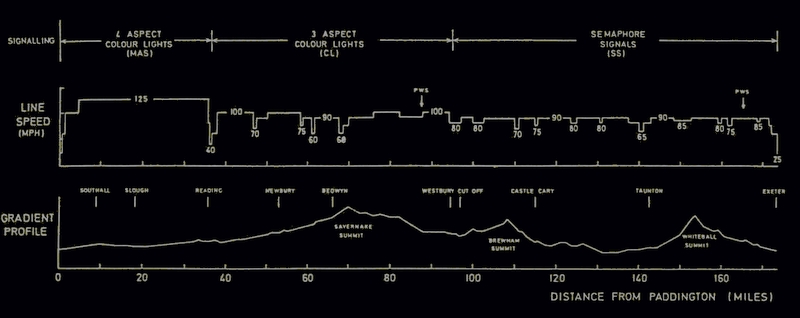
|
Appendix 2. Schedule
| Distance (miles) |
Location | Scheduled Time | ||
|---|---|---|---|---|
| Cornish Riviera (1B52) |
Loco-hauled relief (1Z16) |
|||
| 0.0 | Paddington | Dep | 10:25 | 10:27 |
| 9.0 | Southall | Pass | 10:325 | 10:36 |
| 18.3 | Slough | Pass | 10:37 | 10:43 |
| (Recovery Time +1 min) | ||||
| 35.9 | Reading | Arr | 10:47 | 10:56 |
| Dep | 10:49 | 10:58 | ||
| 53.0 | Newbury | Pass | 11:02 | 11:13 |
| 66.3 | Bedwyn | Pass | 11:11 | 11:23 |
| (Recovery Time +3 min) | ||||
| 94.5 | Heywood Rd Jn | Pass | 11:34 | 11:46 |
| 115.1 | Castle Cary | Pass | 11:49 | 12:02 |
| (Recovery Time +2 min) | ||||
| 142.6 | Taunton | Pass | 12:10 | 12:25 |
| 153.4 | Whiteball | Pass | 12:18 | 12:34 |
| (Recovery Time +3 min) | ||||
| 173.4 | Exeter | Arr | 12:35 | 12:52 |
Bibliography
Riviera Express: The Train And Its Route, G. Body, Publ. Avon-Anglia, ISBN 0 905466 26 8
Diesel Enthusiast's Pocket Guide (Vol 8 Wessex and the West Country), M. Oakley, Publ. Bradford Barton, ISBN 0 85153 409 0
Illustrated Rail Route To The West Of England, P. Holland, Publ. Hart & Allan, ISBN 0 90635 00 3
British Rail Main Line Gradient Profile, Publ. Ian Allan, ISBN 0 7110 0875 2
BR 125 High Speed Trains, R. Tiller and M. Oakley, Publ. Bradford Barton, ISBN 0 85153 387 6
The Fifty-Fifties: EE Class 50 diesel-electrics, M. Oakley & R. Tiller, Publ. Bradford Barton, ISBN 0 85153 354 X
Class 47 diesels, A.T.H. Tayler et al, Publ. Ian Allan, ISBN 0 7110 0915 5
Screen Designers
The following utilities are also available to allow you to edit the supplied screens of this game:
Cheats
Download
A digital version of this item can be downloaded right here at Everygamegoing (All our downloads are in .zip format).
| Download | What It Contains |
|---|---|
| A digital version of Cornish Riviera suitable for BeebEm (PC (Windows)), PcBBC (PC (MS-DOS)), Model B Emulator (PC (Windows)) |
Report A Problem
We thank you from the bottom of our hearts if you report something wrong on our site. It's the only way we can fix any problems!
You are not currently logged in so your report will be anonymous.
Add Note
Release Country
Change the country to update it. Click outside of this pop-up to cancel.
Scan Of Selected Article
If you auction an item, it will no longer show in the regular shop section of the site.







